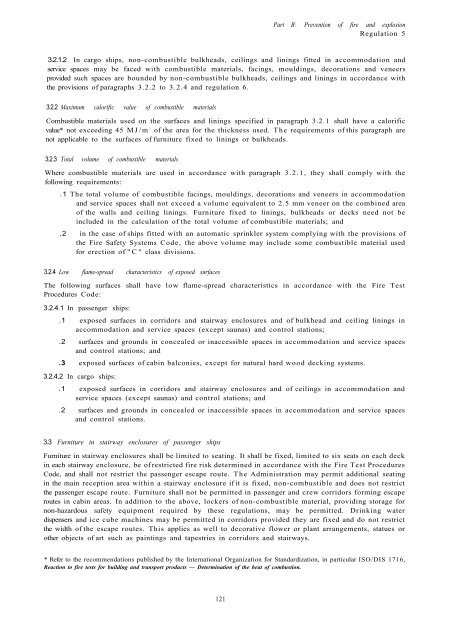Solas Consolidated Edition 2009.pdf
Solas Consolidated Edition 2009 for maritime
Solas Consolidated Edition 2009 for maritime
Create successful ePaper yourself
Turn your PDF publications into a flip-book with our unique Google optimized e-Paper software.
Part B: Prevention of fire and explosion<br />
Regulation 5<br />
3.2.1.2 In cargo ships, non-combustible bulkheads, ceilings and linings fitted in accommodation and<br />
service spaces may be faced with combustible materials, facings, mouldings, decorations and veneers<br />
provided such spaces are bounded by non-combustible bulkheads, ceilings and linings in accordance with<br />
the provisions of paragraphs 3.2.2 to 3.2.4 and regulation 6.<br />
3.2.2 Maximum calorific value of combustible materials<br />
Combustible materials used on the surfaces and linings specified in paragraph 3.2.1 shall have a calorific<br />
value* not exceeding 45 MJ/m 2<br />
of the area for the thickness used. The requirements of this paragraph are<br />
not applicable to the surfaces of furniture fixed to linings or bulkheads.<br />
3.2.3 Total volume of combustible materials<br />
Where combustible materials are used in accordance with paragraph 3.2.1, they shall comply with the<br />
following requirements:<br />
.1 The total volume of combustible facings, mouldings, decorations and veneers in accommodation<br />
and service spaces shall not exceed a volume equivalent to 2.5 mm veneer on the combined area<br />
of the walls and ceiling linings. Furniture fixed to linings, bulkheads or decks need not be<br />
included in the calculation of the total volume of combustible materials; and<br />
.2 in the case of ships fitted with an automatic sprinkler system complying with the provisions of<br />
the Fire Safety Systems Code, the above volume may include some combustible material used<br />
for erection of "C" class divisions.<br />
3.2.4 Low flame-spread characteristics of exposed surfaces<br />
The following surfaces shall have low flame-spread characteristics in accordance with the Fire Test<br />
Procedures Code:<br />
3.2.4.1 In passenger ships:<br />
.1 exposed surfaces in corridors and stairway enclosures and of bulkhead and ceiling linings in<br />
accommodation and service spaces (except saunas) and control stations;<br />
.2 surfaces and grounds in concealed or inaccessible spaces in accommodation and service spaces<br />
and control stations; and<br />
.3 exposed surfaces of cabin balconies, except for natural hard wood decking systems.<br />
3.2.4.2 In cargo ships:<br />
.1 exposed surfaces in corridors and stairway enclosures and of ceilings in accommodation and<br />
service spaces (except saunas) and control stations; and<br />
.2 surfaces and grounds in concealed or inaccessible spaces in accommodation and service spaces<br />
and control stations.<br />
3.3 Furniture in stairway enclosures of passenger ships<br />
Furniture in stairway enclosures shall be limited to seating. It shall be fixed, limited to six seats on each deck<br />
in each stairway enclosure, be of restricted fire risk determined in accordance with the Fire Test Procedures<br />
Code, and shall not restrict the passenger escape route. The Administration may permit additional seating<br />
in the main reception area within a stairway enclosure if it is fixed, non-combustible and does not restrict<br />
the passenger escape route. Furniture shall not be permitted in passenger and crew corridors forming escape<br />
routes in cabin areas. In addition to the above, lockers of non-combustible material, providing storage for<br />
non-hazardous safety equipment required by these regulations, may be permitted. Drinking water<br />
dispensers and ice cube machines may be permitted in corridors provided they are fixed and do not restrict<br />
the width of the escape routes. This applies as well to decorative flower or plant arrangements, statues or<br />
other objects of art such as paintings and tapestries in corridors and stairways.<br />
* Refer to the recommendations published by the International Organization for Standardization, in particular ISO/DIS 1716,<br />
Reaction to fire tests for building and transport products — Determination of the heat of combustion.<br />
121


